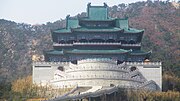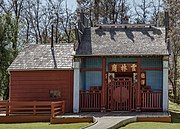User:Ivy Zhao 0704/Taoist temple
Overall Introduction of Taoist Temple
[edit]| Part of a series on |
| Taoism |
|---|
 |
A Taoist temple(traditional Chinese: 觀; simplified Chinese: 观; pinyin: guàn, also called 道观 dàoguàn and 宫观, is a place where the Tao is observed and cultivated it is a place of worship in Taoism.
Structure and function can vary according to the Taoist school the temple belongs to. For example, guàn of the Quanzhen School are monasteries where celibate Taoist priests live.
In front of the main gate are the holy statues of Dragon and Tiger. The Three Pure Ones are worshipped inside. Taoist temples are carved with Chinese characters like Fu (blessing), Shou (longevity), Ji (auspicious), reflecting the theme of long and fruitful life.[1]
The origin of the Taoist Temple could be related to the Buddhist temples, and then developed its own styles. The site of building the Taoist Temple also needed to be carefully chosen that most of them were build on mountain, in the forest, and some other places far away from the city to provide quiet and tranquil environment for the monasteries.
The Origin of Taoist Temple
[edit]Taoism is a religion that originated in China with the belief in immortality, which urges people to become immortal by the form of moral and health cultivation.[2] During the Southern Dynasty, under the influence of Buddhist monasteries, monasticism became the new trend, and Taoists were also trying to create a new way of monasticism by imitating the mode of Buddhist. Therefore, many of the Taoist houses were built in a similar pattern to Buddhist monasteries. Although its scale can not be compared to the Buddhist monasteries, their form and pattern are similar, including the courtyard-like layout, the hall-like architecture, and the enshrining statues. Moreover, the large Taoist Temple also functioned as an economic entity, which is also similar to Buddhism. The official Taoist temple has magnificent buildings and different offerings, with halls, statues, gardens, and even industries. It also contains different building spaces for different purposes, for example, the medicine garden and orchard, ponds, and gardens for trees and flowers.
The Taoist temple is a place for Taoists to practice, so monasticism is closely related to where the temple is built. Taoist were asked to cultivate virtues, and monasticism can help them get rid of hardship and troubles and lead to a peaceful life. Their aim was to find a state of tranquility in the psychological and spiritual world. Therefore, monasticism was put in the highest place in Taoism.[3]
Environment Requirement for Taoist Temple
[edit]

There are many ways to practice Taoism, such as praying, keeping thoughts, nurturing, internal elixir and external elixir, and so on. But no matter what practices they are experiencing, quietness and inaction are needed. Therefore, it requires quietness and freedom from the disturbance of the outer world. To be far away from the noisy and busy cities, most of the Taoism temples are built in deep forests to practice monasticism. Even though there are Taoist temples in the city, most of them are located in quiet and open spaces like mountains and forests, which is also similar to Buddhist temples.[3]
Introduction to the Famous Taoist Temples
[edit]Sanqing Guan: located opposite the town government of Chengzitan, Pulandian, Dalian City, Liaoning Province, was built in the 15th century during the Wanli period of the Ming Dynasty and had a history of more than 400 years.[4] In 1998, it was listed as a cultural relic protection unit in Pulandian City. Its scale is the first in the Dalian area. It is named Sanqing Guan because of the statue of Sanqing Laozu.[4]
Baiyun Guan: Located on Binhe Road outside Guang'anmen, Xuanwu District, Beijing, it is a famous Taoist temple and the largest surviving Taoist temple building in Beijing, built in the twenty-seventh year of the Tang Dynasty (739), and the existing building was rebuilt in the Qing Dynasty.[5]
The main halls are distributed along the central axis, in the order of the pagoda, the mountain gate, and the Ling Palace. Jade Emperor Hall, Old Law Hall (Seven Truths Hall), Qiu Zu Hall, and Four Royal Halls. There are more than 50 halls in total, large and small, covering an area of about 20,000 square meters, such as the Preceptor's Terrace and the Yunji Mountain House.[4] It is built by absorbing the characteristics of the north and south palaces and gardens, with magnificent halls and elegant scenery, and the halls are decorated with Taoist patterns.[5]
Kuixing Lou: Chengde Kui Xing Lou is one of the famous Taoist buildings in northern China, located in Chengde City, Hebei Province, and was founded in 1828 AD.[6] Hai Zhong, the then governor of Chengde, built this Taoist temple dedicated to the Taoist deity "Kui Xing Shen" in order to pray for the cultural prosperity of the area under his jurisdiction. Before the 20th century, this type of building was found in many places in China.[6] Chengde Kui Xing House is currently the largest Taoist temple in China dedicated to Kui Xing and the only Taoist activity in the region, where large Taoist ceremonies and temple fairs are held regularly, and many people come to worship.[6]
Different Types of Taoist Temple
[edit]The palaces of the Taoist Temple have two natures: one is the descendant temple(Zisun miao), and the other is the jungle temple(Conglin miao).
The descendant temples are passed down from generation to generation, from master to disciple, and the temple property can be inherited by an exclusive sect. Daoists from other sects can live in the temple temporarily but cannot interfere with the temple affair. Usually, the new disciples live in the descendant temple.
The jungle temples are not allowed to take in new disciples, and the temple property cannot be inherited and belongs to all Taoist congregations in the world in common. Inspired by Zen Buddhism, Taoism also gradually shifted from the Tang Dynasty to emphasize inner purification and inaction and heavy metaphysics. The Quanzhen school also established the Jungle system of Taoism with reference to the Zen forest system[7]. Jungle temples are generally non-sectarian, and all Daoist Dharma have the right to live in and manage temple affairs. Generally, regardless of age, gender, or duration of monasticism, any Daosit who can reside in it has the right to be elected as the top leader. Daoists who have lived in the jungle temple for a long time are called permanent Daoists[7]. There is a clear division of labor in the temple, commonly known as the “three masters, five masters, and eighteen heads,” who are in charge of sutra teaching, merit-making, security, fasting, staff placement, self-support, cooking, and other matters. Generally, the new disciples first learn this knowledge in the descendant temple, and after three years, they get the crown scarf and permission from the master; then, they can go to the jungle temple to live alone and learn more. After the study, they return again.
In addition, the sect is not determined by which temple the monk leaves home in. Rather, it is decided by the dharma descent, who grant s the sect name according to the sect. And after that, wherever one goes, it is the same sect, and one can also live in the temple of descendants or in the jungle temple, as long as it is suitable[7]. Generally, the temple where a new monk lives is the temple of his own sect, but not absolutely, as a rule. After having a master, if you meet a better Taoist priest, you can worship “teacher” again, and you don’t have to change your descent. The Yellow Emperor studied the Tao and had 72 “masters.”[3] There is only one Taoist master, but the more masters you can have, the better. Because it means you are diligent and good at learning.
Gallery
[edit]-
Exterior of the Xianguding Temple (traditional Chinese: 仙姑頂; simplified Chinese: 仙姑顶; pinyin: Xiāngūdǐng), a daoguan in Weihai, Shandong, China
-
Chun Yang Dian of Ching Chung Koon Temple (青松觀), Hong Kong
-
Fung Ying Seen Koon Temple (蓬瀛仙館), Hong Kong
-
Fengshan Tiangong Temple in Kaohsiung, Taiwan
-
Yun Lin Temple, oldest Taoist temple in California, United States
-
San Qing Gong Temple, Singapore
See also
[edit]- Taoism
- Way of the Celestial Masters
- Zhengyi Taoism
- Quanzhen Taoism
- Chinese ritual mastery traditions
- Chinese temple
- Cebu Taoist Temple (Cebu City, Philippines)
References
[edit]- ^ "Taoist Temples in China".
- ^ Li, Gang. "道教文化的现代意义". Retrieved 2023-01-21.
- ^ a b c Jiang, Huyizhan. "道觀的簡介、來源和環境要求". www.toutiao.com (in Chinese (Taiwan)). Retrieved 2023-01-21.
{{cite web}}:|archive-date=requires|archive-url=(help)CS1 maint: url-status (link) - ^ a b c Yun, Xi (2018-08-18). "浅谈三清观的历史由来-古建中国". m.gujianchina.cn. Retrieved 2023-02-11.
- ^ a b Xiao, Ben (2013-09-11). "中国历代著名道观、道长简介(二) – 国学网 - Page 4". www.guoxue.com (in Chinese (China)). Retrieved 2023-02-11.
- ^ a b c "河北承德魁星楼(魁星阁)-汉匠古建筑-寺院设计施工". nbgjz.com. Retrieved 2023-02-11.
- ^ a b c Wang, Zheng (2018-09-28). "禅宗对中国佛教化的影响". www.tibet.com. Retrieved 2023-02-10.







